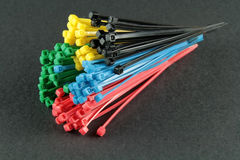Zip Ties Vs. Velcro
There has been much debate whether it is better to use zip ties or Velcro for structured cabling projects. Each have the capacity to pull together attractive cabling projects. They both have their individual strengths and positive attributes, but is one, in fact, superior to the other? Let’s explore.
To begin: the lightweight, sturdy zip tie. Zip ties are a perennial favorite among those in the structured cabling world. Invented in 1958, zip ties were first intended for airplane wire harnesses, but now we’ve expanded their usages and applications. In modern times, zip ties now come in a myriad of sizes, colors, and categories. Due to this, along with their affordability and long-lasting strength, zip ties remain the primary choice among cabling professionals. More advantages of the zip tie include: they come in plenum-rated cable tie versions, which are allotted for use in electrical and HVAC functions. There is also a great zip tie for the more harsh settings, Tefzel® cable tie zip ties. These unique zip ties are resistant to radiation, ultraviolet light, corrosive chemicals, and intense temperatures. Importantly, zip ties consistently demonstrate their durability plus their ability to fit through small holes for wiring jobs and their space conservation.
Next up we have Velcro, or hook and loop fasteners. First developed by Swiss electrical engineer George de Mestral, when, in 1941, while taking a walk with his dog, noticed that burdock seeds would cling to his coat and dog. This is what inspired him to make his first touch fastener, which he then patented in 1955. He refined his product for commercial introduction beginning in the late 1950s. Of course, Velcro wasn’t used for cabling purposes at first. At its start, Velcro was intended to be the “zipperless zipper” in the fashion and textile industry. Today, Velcro is used in many industries, including those that do structured cabling. More and more, Velcro straps are gaining popularity, with some technicians using them exclusively. Velcro wraps are preferred by many due to their ability to be used and reused time and time again. Another advantage of Velcro is that it doesn’t require scissors or a cable tie removal tool to remove it. Despite the fact that Velcro cable ties are by and large more costly than zip ties, many consider the extra cost worth it because they are able to reuse it. Velcro straps come in a bunch of sizes, plus large continuous rolls, which can be cut and customized to fit the length requirements for the job at hand. Overall, Velcro straps are thought to have the advantage when dealing with extremely large bundles.
It should be noted that many people select a combination of zip ties and Velcro for cable management. In general, Velcro straps are used for temporary jobs and/or large bundles, and zip ties are best for permanent or semi-permanent jobs.
The Take-Away:
Given their unique strengths and weaknesses, it is difficult to make a definitive call on which is best. Perhaps we can conclude that each have their place in a cable technician’s arsenal, depending on the job.





